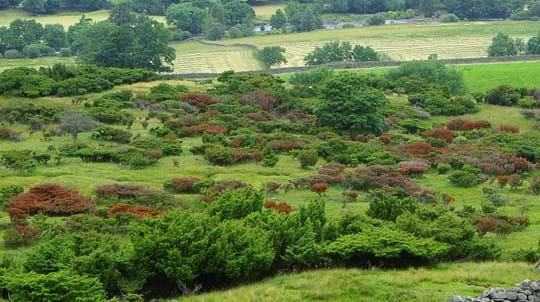
Pests and diseases
Phytophthora austrocedri
A pathogen that infects and can kill junipers.

Principal Pathologist - Forest Research
Juniper is one of our three native conifers and Scotland is the UK’s stronghold for this sometimes overlooked tree. We know that juniper has been in decline for many years with heavy animal browsing and habitat loss blamed for decreasing numbers. However, Forest Research scientists have found that a Phytophthora first discovered in Argentina in 2007, Phytophthora austrocedri, may also be contributing to the loss of our junipers.
This species of Phytophthora was found in Great Britain in 2011 for the first time and appears to like cool temperatures and thrive in boggy, poorly drained soils. We now know it is widely distributed on juniper trees in the Cairngorm region of Scotland and the Lake District (confirmed infections map) where it is causing the death of many trees. It does this by attacking the juniper roots, and extending up into the lower stem of infected trees. Eventually the trees die back as the main stem is girdled by the bark killing Phytophthora austrocedri. Watch out for junipers with reddish or brown foliage, which can be a sign that Phytophthora austrocedri is active.
Forest Research scientists, led by Sarah Green, are exploring the similarities between the Argentinean and British populations of Phytophthora austrocedri as these are the only countries where this Phytophthora species has been found. So far all the signs suggest that the two populations are genetically distinct, telling us that the outbreak in Britain is unlikely to have originated in Argentina or vice versa. It also appears that juniper berries may become infected with the pathogen, raising the possibility that Phytophthora austrocedri could be moved around on contaminated berries or seeds. Plantlife Scotland is so concerned about this threat to native juniper that it is carrying out a survey to find out how healthy junipers are throughout Scotland.
Some worried people have asked whether this might be the end of the quintessential gin and tonic, as juniper berries are the crucial ingredient in gin.
However, don’t panic yet as our gin berries are imported from Europe and the pathogen is not currently known to occur in wild juniper populations in Europe.
Confusingly, this pathogen has undergone a name change since its first discovery. It started as Phytophthora austrocedrae, migrated to Phytophthora austrocedri and occasionally is even referred to (incorrectly) as Phytophthora austrocedrea. However, remember that the ‘i’s have it, and you won’t go far astray on the name!